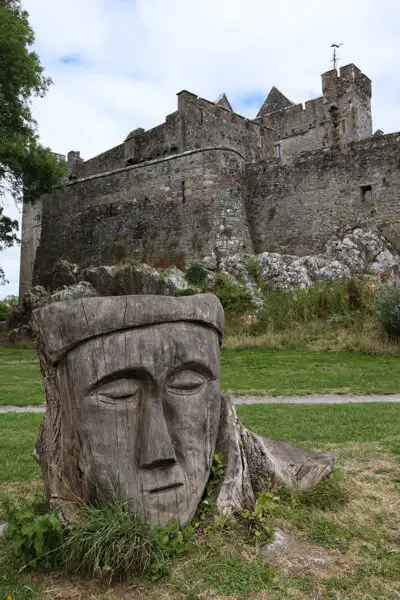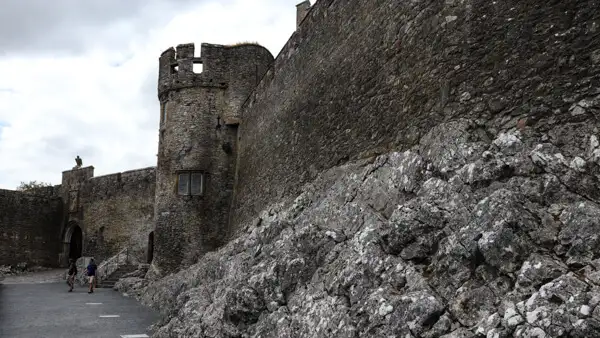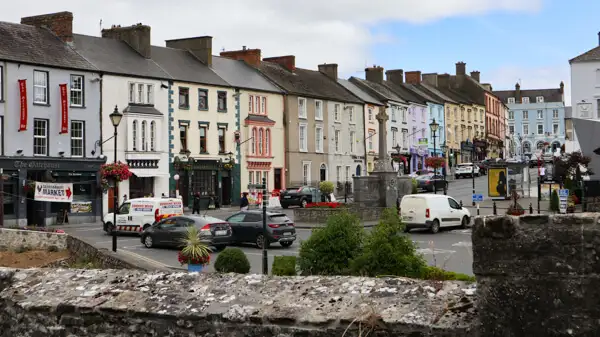Cahir Castle is one of the lesser-known castles in Ireland – quite wrongly, because it is actually a “star”, a film star even….

History and background
This pearl of a castle stands in the village of the same name, Cahir. The Gaelic name of the village was “An Chathair”, which means stone fort.
The small village has only around 4000 inhabitants, but with its colourful houses is a beautiful example of a small rural Irish town.
Situated on two important roads and the River Suir, the location was already strategically interesting in the Middle Ages. The forerunner of today’s castle was built in the 12th century by Conor O’Brien, an Irish clan lord.
The castle was subsequently extended further and further. Today’s Cahir Castle dates mainly from the 13th and 14th centuries and was developed into a fortress by the influential Butler family, who were loyal to England.
Today, the beautiful castle is one of the largest Anglo-Norman castles in Ireland and probably the best preserved.
The Normans had gained much experience in the Crusades and brought their knowledge back with them to Europe. Cahir Castle became a very sophisticated defence system and was considered “state of the art” and practically impregnable in its day.
The castle stands on a rocky island in the middle of the River Suir and is surrounded by water. A bridge leads to the island and a ramp to the first gate. The ramp is adjacent to the castle wall and the other side also has a moat and a wall. Anyone entering the gate can be shot at with arrows from above.

The gate is protected by two towers. There are 6 towers in total to protect the walls. This leads to the outer castle courtyard. The inner courtyard is slightly higher and protected by another gate. The oriels above the gate are called “murder holes”, from where tar or other hot liquids could be poured on attackers at the gate.
The inner courtyard is home to the castle cemetery and the great hall. The hall has been beautifully restored and the enormous antlers of a giant Irish deer from the Ice Age adorn the wall above the fireplace.
The keep is the innermost part of the castle and is a large tower with an adjoining residential building. The spiral staircase leading up to it is narrow and winds round to the right. This is also a defence feature, as right-handed defenders can swing their swords down a right-handed staircase better than right-handed attackers fighting their way up the stairs. There are also “murder holes” and numerous loopholes here, as everywhere in the castle.

In fact, this ingenious fortress was never taken – until 1599.
In the meantime, power-hungry Europe had discovered the destructive power of gunpowder and England was no exception.
Irish rebels had taken up the fight against the English crown all over the country, but especially in the south of Ireland, and entrenched themselves in several castles of sympathising lords and clan chiefs, including Cahir Castle.
Queen Elizabeth I sent her favourite, Robert Devereux, the 2nd Earl of Essex, to Ireland with an army of 17,000 soldiers and 1,300 horses, which was enormous by the standards of the time, to contain the rebellion.
His main task was to defeat the army of Hugh O’Neill, the 2nd Earl of Tyrone, an Irish clan chief and nobleman from the north. However, the headstrong Earl of Essex avoided any contact with Hugh O’Neill’s troops and instead led a campaign in the south of Ireland – much to the displeasure of his queen.
The English also carried two cannons with them and it was these that were ultimately decisive in the siege, as they were used to shoot large holes in the thick walls of the castle. The medieval walls no longer had much to offer against the new cannons. The occupiers surrendered to the English as they began to storm the castle through the walls.

Back in England, the Earl of Essex made a great fuss about the conquest of the castle, but Elizabeth I was not very fond of his disobedience and played down his success.
As time went on, the former favourite Robert Devereux (Earl of Essex) fell more and more out of favour, not least due to his failure in Ireland, as Hugh O’Neill’s rebel army remained undefeated for the time being.
Robert returned to England in 1599 against the direct orders of the Queen. Just one year later, in 1600, Cahir Castle was recaptured by rebels.
In 1601, Robert Devereux attempted a coup d’état against the Queen. This failed and Robert was finally beheaded by the executioner in the Tower of London.
In 1650, the English general Oliver Cromwell led a major campaign through Ireland and conquered the castle for the English for the second time. Cromwell also relied on cannons, of which he brought a large number with him.

Conclusion
Cahir is a lovely little village with rural charm and Cahir Castle is certainly one of the most beautiful castles in Ireland.
It’s all the more surprising that the place is almost spared from tourists. I’ve been to Cahir several times and really enjoyed how quietly I was able to walk around the beautiful castle, even in the height of summer, without seeing any crowds. I can also highly recommend the guided tour inside the castle.
For me, this is practically a “home game”, as we live in the south-east of Ireland (second home). We are originally from Germany.
If you want me to give you an “insider tip” or “hidden gem”, I can only warmly recommend Cahir Castle! You find more information here: https://heritageireland.ie/places-to-visit/cahir-castle/.
Several film directors probably thought so too, as the beautiful castle has already featured in the film “Excalibur” and also in the series “The Tudors”, as well as in “Barry Lyndon”, “Tristan and Isolde” and “Mystic Nights”. So the castle is not only a “star”, but also a “film star”. Perhaps you have already seen the castle in one of these films?
Have fun on your discovery tour of the medieval Cahir Castle!
More interesting articles for you
THE REBELLIOUS TOWN OF ENNISCORTHY
BLARNEY CASTLE AND THE STONE OF ELOQUENCE
Picture credits cover picture: Cahir Castle, photo by Ulrich Knüppel-Gertberg (www.irland-insider.de, www.ireland-insider.com)